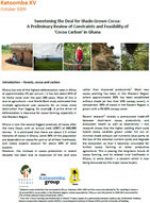Sweetening the Deal for Shade-Grown Cocoa
A Preliminary Review of Constraints and Feasibility of 'Cocoa Carbon' in Ghana
View PublicationThe main implication of these preliminary economic results is that carbon finance alone (at current carbon prices) will not likely be the sole or necessarily the primary means for persuading farmers to adopt higher shade cocoa systems. It could however be an enabling factor to encourage improved farming practices and productivity. The models imply that tree tenure reform, combined with policy, fiscal and institutional reforms in the cocoa sector, will be important drivers of ‘improved’ cocoa farming practices, including increased shade. Realizing the full potential of cocoa carbon will require concurrent progress in policy and legal reforms, as well as building practical experience on the ground. Demonstration activities, working closely with rural communities, farmer organizations and industry, will shed light on practical issues of how to promote improved farming practices, where carbon finance could play a catalytic role, and what impact specific policy reforms could potentially have. Initially, Afforestation/ Reforestation (A/R) may be a more viable strategy than the REDD options because the trees and (presumably) the carbon rights would belong to the tree planter; A/R can either be form increasing shade cover in new or replanted cocoa plantations, or in the form of tree planting (most likely for timber) as a separate land use next to the cocoa crops.

